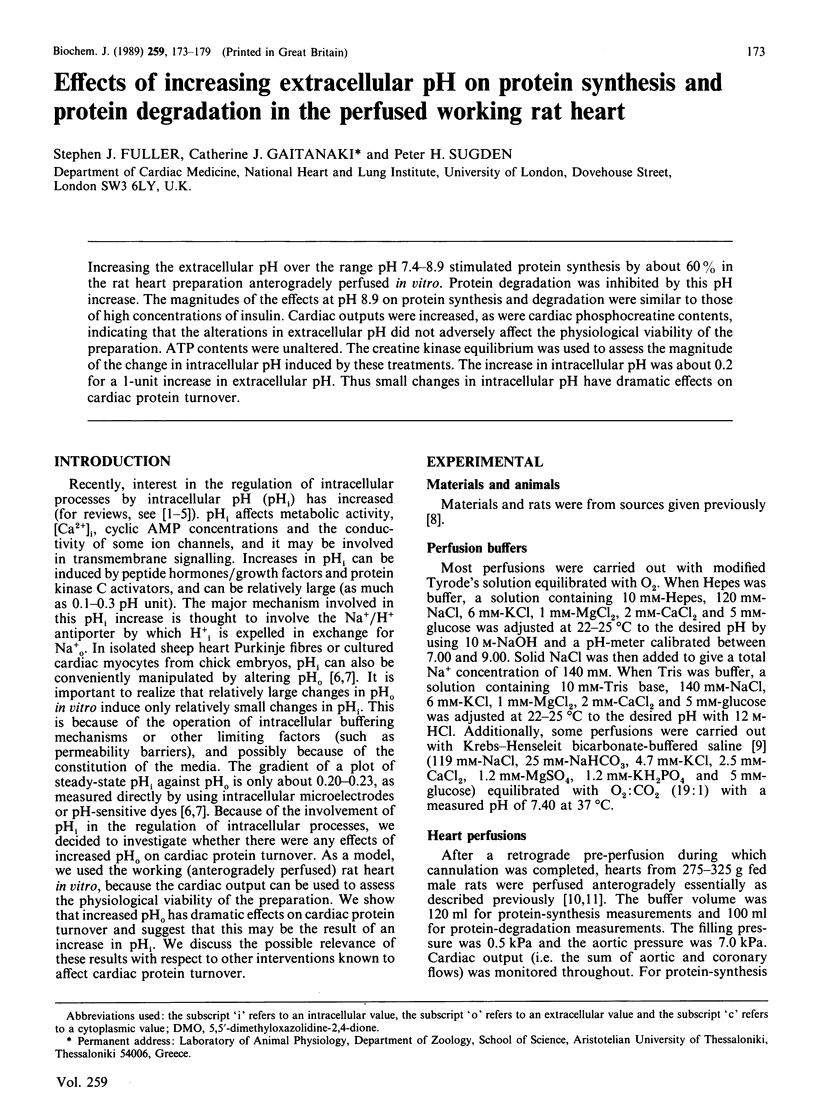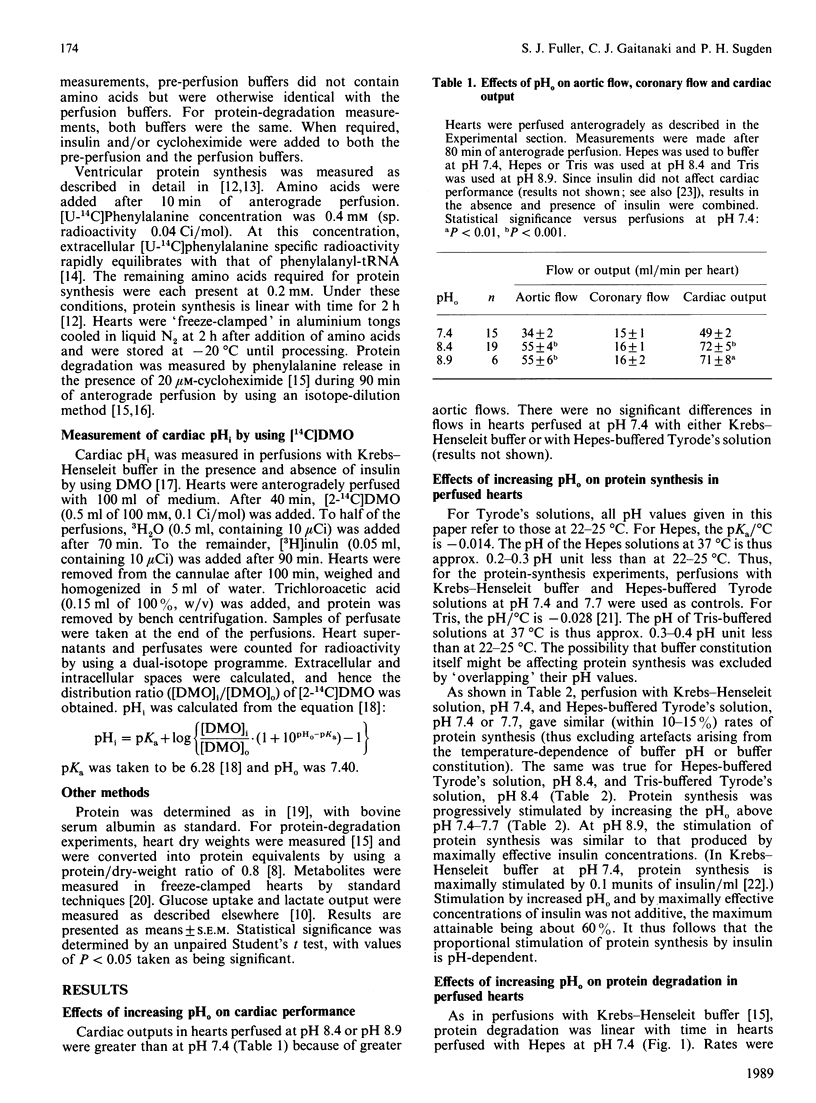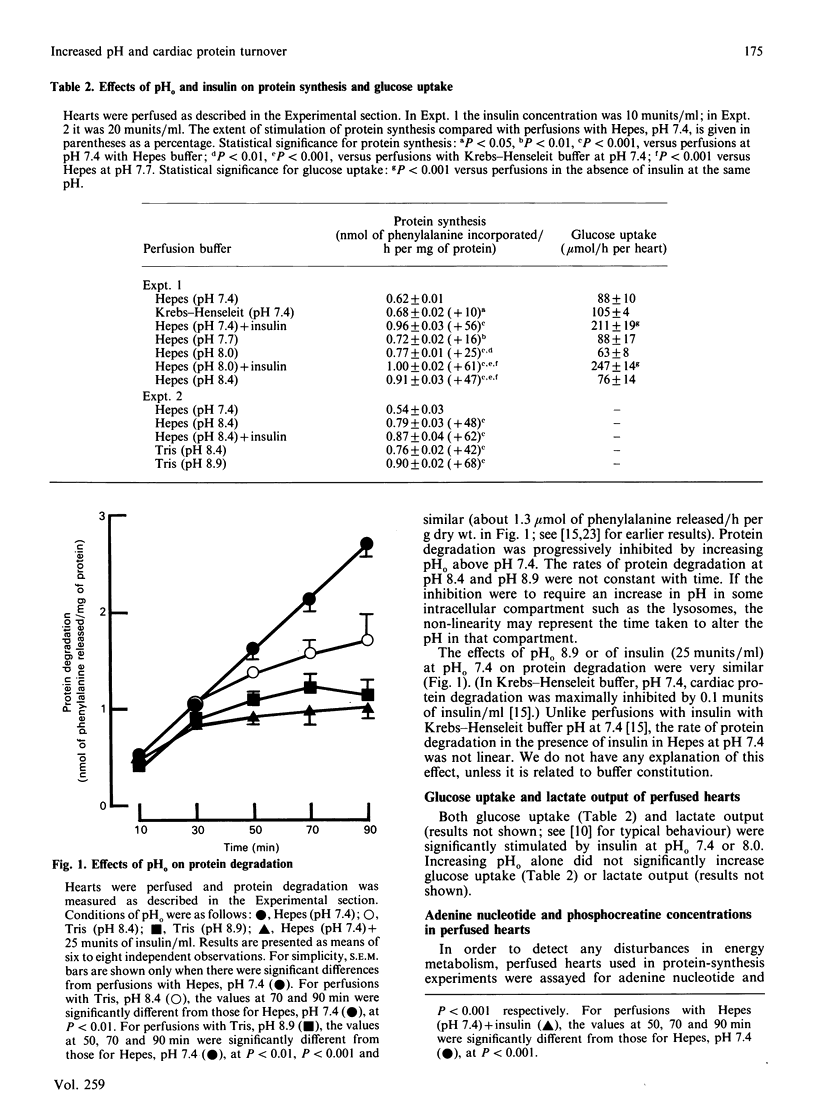Abstract
Increasing the extracellular pH over the range pH 7.4-8.9 stimulated protein synthesis by about 60% in the rat heart preparation anterogradely perfused in vitro. Protein degradation was inhibited by this pH increase. The magnitudes of the effects at pH 8.9 on protein synthesis and degradation were similar to those of high concentrations of insulin. Cardiac outputs were increased, as were cardiac phosphocreatine contents, indicating that the alterations in extracellular pH did not adversely affect the physiological viability of the preparation. ATP contents were unaltered. The creatine kinase equilibrium was used to assess the magnitude of the change in intracellular pH induced by these treatments. The increase in intracellular pH was about 0.2 for a 1-unit increase in extracellular pH. Thus small changes in intracellular pH have dramatic effects on cardiac protein turnover.
Full text
PDF






Selected References
These references are in PubMed. This may not be the complete list of references from this article.
- Bailey I. A., Radda G. K., Seymour A. M., Williams S. R. The effects of insulin on myocardial metabolism and acidosis in normoxia and ischaemia. A 31P-NMR study. Biochim Biophys Acta. 1982 Feb 10;720(1):17–27. doi: 10.1016/0167-4889(82)90034-9. [DOI] [PubMed] [Google Scholar]
- Bers D. M., Ellis D. Intracellular calcium and sodium activity in sheep heart Purkinje fibres. Effect of changes of external sodium and intracellular pH. Pflugers Arch. 1982 Apr;393(2):171–178. doi: 10.1007/BF00582941. [DOI] [PubMed] [Google Scholar]
- Busa W. B. Mechanisms and consequences of pH-mediated cell regulation. Annu Rev Physiol. 1986;48:389–402. doi: 10.1146/annurev.ph.48.030186.002133. [DOI] [PubMed] [Google Scholar]
- Busa W. B., Nuccitelli R. Metabolic regulation via intracellular pH. Am J Physiol. 1984 Apr;246(4 Pt 2):R409–R438. doi: 10.1152/ajpregu.1984.246.4.R409. [DOI] [PubMed] [Google Scholar]
- Chin K. V., Cade C., Brostrom C. O., Galuska E. M., Brostrom M. A. Calcium-dependent regulation of protein synthesis at translational initiation in eukaryotic cells. J Biol Chem. 1987 Dec 5;262(34):16509–16514. [PubMed] [Google Scholar]
- Chua B., Kao R. L., Rannels D. E., Morgan H. E. Inhibition of protein degradation by anoxia and ischemia in perfused rat hearts. J Biol Chem. 1979 Jul 25;254(14):6617–6623. [PubMed] [Google Scholar]
- Chua B., Siehl D. L., Morgan H. E. Effect of leucine and metabolites of branched chain amino acids on protein turnover in heart. J Biol Chem. 1979 Sep 10;254(17):8358–8362. [PubMed] [Google Scholar]
- Deitmer J. W., Ellis D. Interactions between the regulation of the intracellular pH and sodium activity of sheep cardiac Purkinje fibres. J Physiol. 1980 Jul;304:471–488. doi: 10.1113/jphysiol.1980.sp013337. [DOI] [PMC free article] [PubMed] [Google Scholar]
- Ellis D., MacLeod K. T. Sodium-dependent control of intracellular pH in Purkinje fibres of sheep heart. J Physiol. 1985 Feb;359:81–105. doi: 10.1113/jphysiol.1985.sp015576. [DOI] [PMC free article] [PubMed] [Google Scholar]
- Fabiato A., Fabiato F. Effects of pH on the myofilaments and the sarcoplasmic reticulum of skinned cells from cardiace and skeletal muscles. J Physiol. 1978 Mar;276:233–255. doi: 10.1113/jphysiol.1978.sp012231. [DOI] [PMC free article] [PubMed] [Google Scholar]
- Flaim K. E., Kochel P. J., Kira Y., Kobayashi K., Fossel E. T., Jefferson L. S., Morgan H. E. Insulin effects on protein synthesis are independent of glucose and energy metabolism. Am J Physiol. 1983 Jul;245(1):C133–C143. doi: 10.1152/ajpcell.1983.245.1.C133. [DOI] [PubMed] [Google Scholar]
- Frelin C., Vigne P., Ladoux A., Lazdunski M. The regulation of the intracellular pH in cells from vertebrates. Eur J Biochem. 1988 May 16;174(1):3–14. doi: 10.1111/j.1432-1033.1988.tb14055.x. [DOI] [PubMed] [Google Scholar]
- Fuller S. J., Sugden P. H. Acute inhibition of rat heart protein synthesis in vitro during beta-adrenergic stimulation or hypoxia. Am J Physiol. 1988 Oct;255(4 Pt 1):E537–E547. doi: 10.1152/ajpendo.1988.255.4.E537. [DOI] [PubMed] [Google Scholar]
- Fuller S. J., Sugden P. H. Stimulation of protein synthesis, glucose uptake and lactate output by insulin and adenosine deaminase in the rat heart. FEBS Lett. 1986 Jun 9;201(2):246–250. doi: 10.1016/0014-5793(86)80617-2. [DOI] [PubMed] [Google Scholar]
- Gordon E. E., Kira Y., Demers L. M., Morgan H. E. Aortic pressure as a determinant of cardiac protein degradation. Am J Physiol. 1986 Jun;250(6 Pt 1):C932–C938. doi: 10.1152/ajpcell.1986.250.6.C932. [DOI] [PubMed] [Google Scholar]
- Kerbey A. L., Radcliffe P. M., Randle P. J. Diabetes and the control of pyruvate dehydrogenase in rat heart mitochondria by concentration ratios of adenosine triphosphate/adenosine diphosphate, of reduced/oxidized nicotinamide-adenine dinucleotide and of acetyl-coenzyme A/coenzyme A. Biochem J. 1977 Jun 15;164(3):509–519. doi: 10.1042/bj1640509. [DOI] [PMC free article] [PubMed] [Google Scholar]
- Klip A., Ramlal T., Cragoe E. J., Jr Insulin-induced cytoplasmic alkalinization and glucose transport in muscle cells. Am J Physiol. 1986 May;250(5 Pt 1):C720–C728. doi: 10.1152/ajpcell.1986.250.5.C720. [DOI] [PubMed] [Google Scholar]
- L'Allemain G., Paris S., Pouysségur J. Growth factor action and intracellular pH regulation in fibroblasts. Evidence for a major role of the Na+/H+ antiport. J Biol Chem. 1984 May 10;259(9):5809–5815. [PubMed] [Google Scholar]
- LaManna V. R., Ferrier G. R. Electrophysiological effects of insulin on normal and depressed cardiac tissues. Am J Physiol. 1981 Apr;240(4):H636–H644. doi: 10.1152/ajpheart.1981.240.4.H636. [DOI] [PubMed] [Google Scholar]
- Lawson J. W., Veech R. L. Effects of pH and free Mg2+ on the Keq of the creatine kinase reaction and other phosphate hydrolyses and phosphate transfer reactions. J Biol Chem. 1979 Jul 25;254(14):6528–6537. [PubMed] [Google Scholar]
- Lazdunski M., Frelin C., Vigne P. The sodium/hydrogen exchange system in cardiac cells: its biochemical and pharmacological properties and its role in regulating internal concentrations of sodium and internal pH. J Mol Cell Cardiol. 1985 Nov;17(11):1029–1042. doi: 10.1016/s0022-2828(85)80119-x. [DOI] [PubMed] [Google Scholar]
- Madshus I. H. Regulation of intracellular pH in eukaryotic cells. Biochem J. 1988 Feb 15;250(1):1–8. doi: 10.1042/bj2500001. [DOI] [PMC free article] [PubMed] [Google Scholar]
- McKee E. E., Cheung J. Y., Rannels D. E., Morgan H. E. Measurement of the rate of protein synthesis and compartmentation of heart phenylalanine. J Biol Chem. 1978 Feb 25;253(4):1030–1040. [PubMed] [Google Scholar]
- Moolenaar W. H. Effects of growth factors on intracellular pH regulation. Annu Rev Physiol. 1986;48:363–376. doi: 10.1146/annurev.ph.48.030186.002051. [DOI] [PubMed] [Google Scholar]
- Moolenaar W. H., Tsien R. Y., van der Saag P. T., de Laat S. W. Na+/H+ exchange and cytoplasmic pH in the action of growth factors in human fibroblasts. Nature. 1983 Aug 18;304(5927):645–648. doi: 10.1038/304645a0. [DOI] [PubMed] [Google Scholar]
- Moore R. D. Elevation of intracellular pH by insulin in frog skeletal muscle. Biochem Biophys Res Commun. 1979 Dec 14;91(3):900–904. doi: 10.1016/0006-291x(79)91964-8. [DOI] [PubMed] [Google Scholar]
- Moore R. D., Fidelman M. L., Seeholzer S. H. Correlation between insulin action upon glycolysis and change in intracellular pH. Biochem Biophys Res Commun. 1979 Dec 14;91(3):905–910. doi: 10.1016/0006-291x(79)91965-x. [DOI] [PubMed] [Google Scholar]
- Moore R. D., Rabovsky J. L. Mechanism of insulin action on resting membrane potential of frog skeletal muscle. Am J Physiol. 1979 May;236(5):C249–C254. doi: 10.1152/ajpcell.1979.236.5.C249. [DOI] [PubMed] [Google Scholar]
- Moore R. D. Stimulation of Na:H exchange by insulin. Biophys J. 1981 Feb;33(2):203–210. doi: 10.1016/S0006-3495(81)84881-3. [DOI] [PMC free article] [PubMed] [Google Scholar]
- Preedy V. R., Smith D. M., Kearney N. F., Sugden P. H. Rates of protein turnover in vivo and in vitro in ventricular muscle of hearts from fed and starved rats. Biochem J. 1984 Sep 1;222(2):395–400. doi: 10.1042/bj2220395. [DOI] [PMC free article] [PubMed] [Google Scholar]
- Putnam R. W. Effect of insulin on intracellular pH in frog skeletal muscle fibers. Am J Physiol. 1985 Mar;248(3 Pt 1):C330–C336. doi: 10.1152/ajpcell.1985.248.3.C330. [DOI] [PubMed] [Google Scholar]
- Rubin I. B., Goldstein G. An ultrasensitive isotope dilution method for the determination of L-amino acids. Anal Biochem. 1970 Feb;33(2):244–254. doi: 10.1016/0003-2697(70)90293-9. [DOI] [PubMed] [Google Scholar]
- Schreiber S. S., Oratz M., Rothschild M. A., Smith D. Increased cardiac contractility in high calcium perfusion and protein synthesis. J Mol Cell Cardiol. 1977 Aug;9(8):661–669. doi: 10.1016/s0022-2828(77)80361-1. [DOI] [PubMed] [Google Scholar]
- Smith D. M., Sugden P. H. Differential rates of protein synthesis in vitro and RNA contents in rat heart ventricular and atrial muscle. Biochem J. 1983 Aug 15;214(2):497–502. doi: 10.1042/bj2140497. [DOI] [PMC free article] [PubMed] [Google Scholar]
- Smith D. M., Sugden P. H. Effect of insulin and lack of effect of workload and hypoxia on protein degradation in the perfused working rat heart. Biochem J. 1983 Jan 15;210(1):55–61. doi: 10.1042/bj2100055. [DOI] [PMC free article] [PubMed] [Google Scholar]
- Smith D. M., Sugden P. H. Stimulation of left-atrial protein-synthesis rates by increased left-atrial filling pressures in the perfused working rat heart in vitro. Biochem J. 1983 Dec 15;216(3):537–542. doi: 10.1042/bj2160537. [DOI] [PMC free article] [PubMed] [Google Scholar]
- Sugden P. H., Smith D. M. The effects of glucose, acetate, lactate and insulin on protein degradation in the perfused rat heart. Biochem J. 1982 Sep 15;206(3):467–472. doi: 10.1042/bj2060467. [DOI] [PMC free article] [PubMed] [Google Scholar]
- Sugden P. H., Smith D. M. The effects of insulin on glucose uptake and lactate release in perfused working rat heart preparations. Biochem J. 1982 Sep 15;206(3):473–479. doi: 10.1042/bj2060473. [DOI] [PMC free article] [PubMed] [Google Scholar]
- Taegtmeyer H., Hems R., Krebs H. A. Utilization of energy-providing substrates in the isolated working rat heart. Biochem J. 1980 Mar 15;186(3):701–711. doi: 10.1042/bj1860701. [DOI] [PMC free article] [PubMed] [Google Scholar]
- Vaughan-Jones R. D., Lederer W. J., Eisner D. A. Ca2+ ions can affect intracellular pH in mammalian cardiac muscle. Nature. 1983 Feb 10;301(5900):522–524. doi: 10.1038/301522a0. [DOI] [PubMed] [Google Scholar]
- WADDELL W. J., BUTLER T. C. Calculation of intracellular pH from the distribution of 5,5-dimethyl-2,4-oxazolidinedione (DMO); application to skeletal muscle of the dog. J Clin Invest. 1959 May;38(5):720–729. doi: 10.1172/JCI103852. [DOI] [PMC free article] [PubMed] [Google Scholar]
- ZIERLER K. L. Effect of insulin on membrane potential and potassium content of rat muscle. Am J Physiol. 1959 Sep;197:515–523. doi: 10.1152/ajplegacy.1959.197.3.515. [DOI] [PubMed] [Google Scholar]
- ZIERLER K. L. Increase in resting membrane potential of skeletal muscle produced by insulin. Science. 1957 Nov 22;126(3282):1067–1068. doi: 10.1126/science.126.3282.1067. [DOI] [PubMed] [Google Scholar]


